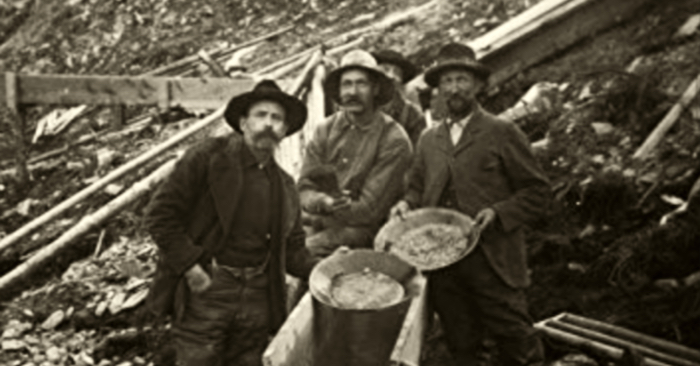
The Stanislaus River flows right through the heart of some of California’s richest gold country. The headwaters start high in the Sierra Nevada Mountains, and much of the river is accessible from public lands of the Stanislaus National Forest. The river continues westward, where it eventually finds its way down to Modesto and then on to the San Joaquin River.
There is gold throughout much of the river, but the lower foothills are where most of the historic mining activity took place, and this is still the best place for a prospector to look. We are generally talking about the area northeast of New Melones Lake.
Towns of special note are Angel’s Camp, Carson Hill, Jamestown, Melones and Sonora.

Early Mining on the Stanislaus River
Placer mining started in the late 1840s and continued in earnest through the 1850s. This was not long after the initial discovery of gold at Sutter’s Mill, some 60 miles to the north. Almost immediately there were thousands of men in this foothills of the Sierras, and just about every creek and river contained gold. The Stanislaus was no exception, and several tent camps sprang up within the next year.
Carson Hill was one of the first established towns on the Stanislaus River. Gold was panned from Carson Creek in 1848, which led to more extensive mining on the river below. Melones and Carson Hill sprang up immediately with nearly 5,000 population by 1851. Melones got its name from the abundant melon-seed sized nuggets in the area. Even after the easy placers were worked out, lode mines sustained the area to a lesser extent for many decades.
On the other side of the river was Columbia, another major mining camp in the area. In fact, for a short time this was actually California’s second largest city! This town was a major supplier to the miners working along the Stanislaus River, but it was also surrounded with gold-bearing tributaries. All of the ground around town had gold within the gravels. So much so that in the 1860s miners dug underneath the town itself to get to the gold.
The richness of this area meant that it fared better than many other mining towns. Although the populations of various mining camps did diminish as years went by, there was enough gold to keep miners working the area for many decades.
Prospecting Access
Access to open gold-bearing ground can be a challenge in this area. Since it is so well-known there are an abundance of mining claims that cover some of the better prospecting areas. These will be off-limits to the public unless you can get permission from the claim holder.
There are certainly some good mining areas within the Stanislaus National Forest that are not claimed and open… you will just have to find them! Yes the river itself contains gold, but many of the smaller tributaries and gulches are also excellent places to search. Many prospectors walk up dry gulches and scan the bedrock with a metal detector to seek out gold nuggets.
If you want access to a very rich area and are willing to invest some money for access, then you can join the Lost Dutchman Mining Association. This is a prospecting club that has access to 160-acres at a place called Italian Bar on the South Fork of the Stanislaus River.
The local prospecting club are the Delta Gold Diggers. This would be a good club to join if you are interested in learning more about gold prospecting in this area.
As you venture up the forks of the Stanislaus River you get into more rugged and remote country. The South Fork is closest to Columbia and is the most accessible. The Middle Fork and North Fork of the Stanislaus cut through some steep canyons. Access is challenging, but a person willing to put in the effort can be rewarded with very good gold by venturing off the beaten path.
Tip: Ditches and aqueducts were dug to supply water to the mines in this area. Much of the best gold is not in the river itself, but actually high above the present waterline. The gold hides within tertiary gravels that the old-timers would wash away using hydraulic monitors. Some of these old hydraulic operations have been all but forgotten, but they are great places to prospect too.
17 of California’s Richest Mining Locations
Metal Detecting Mine Dumps for Hard Rock Gold
Safety While Prospecting in the Backcountry
